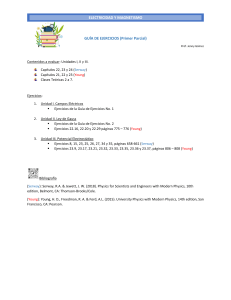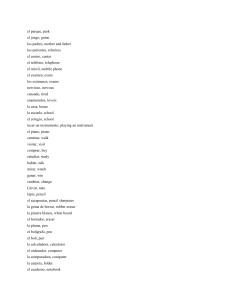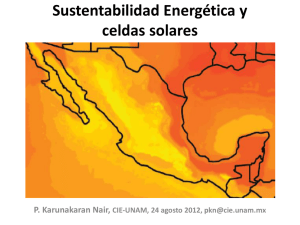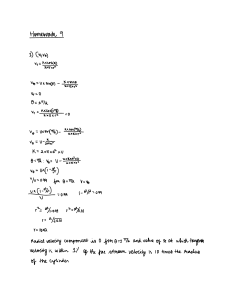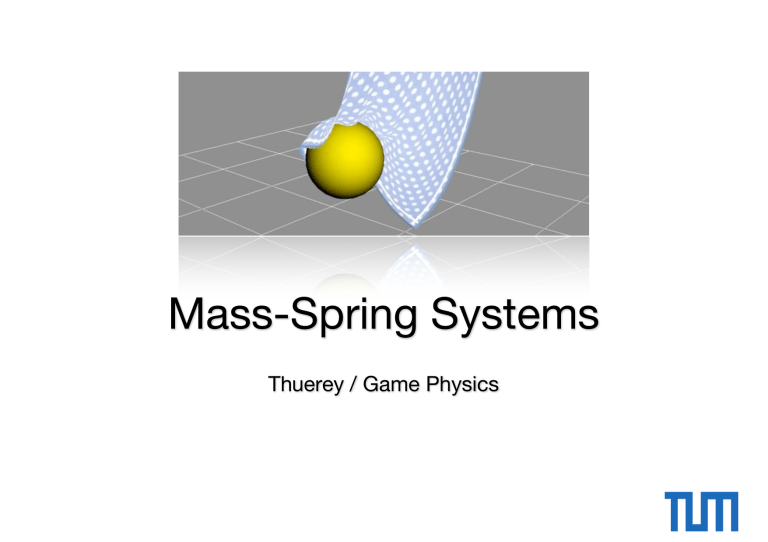
Mass-Spring Systems
Thuerey / Game Physics
Mass-Spring Systems
• Not only:
Game Physics
Applications
• Cloth
• Deformable / elastic objects
• Ropes etc.
Game Physics
Recap Projectile Motion
• Particle, with position x(t)
• Velocity v(t) , acceleration a(t)
• Velocity from position: time derivative
• Position from velocity: integrate over time
• Newton’s 2nd law: F=ma
• E.g., gravity: F=(0, -mg)^T
Game Physics
Recap Projectile Motion
• We have:
dx(t)
v(t) =
dt
• Analytic solution: x(t) =
dv(t)
a(t) =
dt
1 2
gt + v0 t + x0
2
• Note - mass doesn’t matter...
• Only possible for very simple force functions!
Game Physics
Motivation
• We want: world state at time t
• What if acceleration a=f(...) and/or velocity
v=f(...) are really complicated functions?
• Better: discretize & integrate numerically
Game Physics
Learning Outcomes
• Know how to simulate deformable objects
with mass-spring systems
• Physical model for springs
• Numerical integration for ODEs
–Properties of di erent methods
–Be able to apply them
• How to implement
ff
Game Physics
Mass-Spring Systems
Game Physics
Mass-Spring System
• Discretization of object into mass points
(e.g. elastic object, uid, inelastic object etc. ...)
• Interaction between points i and j based on
internal force Fint
ij
• All other forces: external Fext
i
int
ext
F
=
F
+
F
• Overall force i
ij
i
XX
int
int
int
F
Fij = Fji ,
ij = 0
• With
i
fl
Game Physics
j
Mass Points
• Sample with mass points
• Mass of object: M
• Number of points: n
• Assuming uniform mass, for
each point: m=M/n
➡ Simulate the motion of each
mass point
Game Physics
Dynamics
• Physically-based model
• Newtons 2nd law should hold:
X
ext
Fint
+
F
= mai
ij
i
ij
• How to compute internal
forces?
Game Physics
Springs
• Model elasticity with springs
• Hooke’s law:
–Force needed to extend (or
compress) a spring by a distance
is proportional to that distance
Game Physics
Elasticity
• Elasticity: return to rest state
• In contrast to plasticity: keep
current state (or parts of it)
• Extreme: uid
fl
Game Physics
Hookean Spring
• Spring sti ness: k
• Initial length: L
• Current length: l
• Force linear in deformation:
F =
ff
Game Physics
k(l
L)
Directed Force
• Force has direction given
by endpoints of spring
• In vector notation:
Fij =
Game Physics
k(l
L)
xi
xj
l
Total Internal Force
x3
x1
• Summation of spring forces:
Fint
0
L 1 , k1
L 3 , k3
=
X
ki (li
i2{1,2,3}
ext
Fi = Fint
+
F
i
i
x0
L 2 , k2
x2
Game Physics
• External forces: gravity,
user interaction, etc. ...
Li )
x0
xi
li
Dissipative Forces
• Damping: Fdamp (t) =
v(t)
• Models internal friction
• Removes energy from the system
• In practice: often necessary for stabilization
• Counteract numerical errors
Game Physics
System Equations
• Equations of motion for one mass point:
2
d xi (t)
int
ext
mi
=
F
(x
(t))
+
F
i
i
i (t)
2
dt
Acceleration
Game Physics
Elastic forces
Note: depend on
current position!
dxi (t)
dt
Damping
Note: depends
on velocities
Implementation
• Straight forward approach
dx(t)
– We know v(t) =
,
dt
dv(t)
a(t) =
dt
– Euler step (cf. Game Engine Design lecture)
– Integrate velocity and position in time
Game Physics
C++ Suggestions
• Spring class:
class Spring
{
public:
int
point1;
int
point2;
float stiffness;
float initialLength;
[float currentLength;]
...
}
Game Physics
(not necessary, but can be useful...)
C++ Suggestions
• Mass point class:
class Point
{
public:
Vector3
Vector3
Vector3
float
float
...
}
Game Physics
position;
velocity;
force;
mass;
damping;
C++ Suggestions
• Simulation loop:
while(...)
{
for all points i
point[i].clearForce()
point[i].addGravity()
for all springs s
spring[s].computeElasticForces()
spring[s].addToEndPoints()
// …evaluate other forces, eg, user interaction…
integratePositions()
integrateVelocity()
}
Game Physics
Alternative (cf. I. Millington)
• Generic force generators
– Linked to one mass point
– Evaluates force function, and accumulates
• Pros / Cons
– Clean interface for force generators
– Spring stores other point, but only adds to source
– Two spring instances needed for one spring
Game Physics
Simple Collisions
• Ground plane at z=0
– Compute new positions
– Then enforce z>=0 for all points
– Spring forces will keep whole objects above
ground
!
r
e
t
a
l
s
n
o
i
s
i
l
l
o
c
n
More o
Game Physics
Implementation Notes
• Heavy objects
– Give very high mass -> no movement
– Better: don’t even update positions!
– Spring forces will in uence other points
nonetheless
–E.g., add ag to Point class:
fl
fl
Game Physics
bool isFixed;
Analytic Integration Methods
Game Physics
System Equations
• Equations of motion:
d2 xi (t)
int
ext
mi
=
F
(x
(t))
+
F
i
i
i (t)
2
dt
dxi (t)
dt
• Problem: we want x(t+h) , but acceleration depends on
complicated function in x(t)!
• Rewrite & classify:
d2 x
m 2 = g + f (x)
dt
x00 = f (t, x, x0 )
Game Physics
dx
dt
ODE!
Note
• Change of Notation
– For simulations usually: x denotes position (vector)
– In the following: x is free variable
– Function is y(x) (e.g., to compute state of object)
– ...historical reasons
–Thus: x corresponds to simulation time t (for now)
Game Physics
Classi cation
• One free variable x
• Function of highest derivative of solution y(x):
y (n) = f (x, y, y 0 , y 00 , .., y n
1
)
– > Ordinary di erential equation (ODE)
• Highest derivative de nes order of ODE
fi
ff
fi
Game Physics
Example: 1st Order ODE
0
Example Trajectory
y = f (x, y)
0
Whole Vector Field
y = f (x, y)
0
y = f (x, y)
0
y = f (x, y)
[Bara &Witkin, Siggraph’97 course]
ff
Game Physics
y 0 = f (x, y)
ODEs
• ODE of rst order: y0 = f (x, y)
Remember: y(x) written as y
• Example
• Solution
dy
y
+ =
dx x
4, x>0
C
y=
x
2x
• C is integration constant, to determine it...
• Initial condition needed, e.g. , y(1)=1
• Gives C=3
fi
Game Physics
ODEs
• Second order ODE:
• Solution de ned by two initial conditions
• I.e. y(x0 ) = y0 , y0 (x0 ) = y00
y 00 = f (x, y, y 0 )
• Can be converted into a system of two rst
order ODEs: y10 (x) = y2 (x)
y20 (x) = f (x, y1 , y2 )
fi
fi
Game Physics
ODEs
• Problems for which...
– n initial conditions are given: initial value problems
– conditions are distributed to di erent locations:
boundary value problems
– (The latter are usually trickier to solve...)
ff
Game Physics
Outlook
• Partial di erential equations (PDEs): derivatives
with respect to di erent free variables
• Example: 1D di usion
@y(z, t)
@ 2 y(z, t)
=k
@t
@2z
• Note: boundary value problems with PDEs
very important in practice
ff
ff
ff
Game Physics
Analytics Solutions for Mass Spring Systems
• Simpli ed setup: 1D Spring, xed at
top (3D spring possible, though)
• Displacement from rest x, initial d
• Thus F
= − kx
k
x
m
00
x
=
• Resulting ODE:
• Harmonic oscillator
x(t) = d cos(
fi
fi
Game Physics
r
k
t)
m
Analytics Solutions for Mass Spring Systems
• We can include damping!
• Gives:
Game Physics
x(t) = e
t
d cos(
r
k
t)
m
Summary
• Analytic solution:
–gives position for arbitrary time
• Will not blow up, no drift!
• Still - not useful in practice
– Only for simpli ed setups
– Not possible for more complex (i.e.
realistic) spring networks
fi
Game Physics
Numerical Integration
Game Physics
Taylor Expansion
• Start with local Taylor series of the solution
• Discrete step in free variable: xn+1 = xn + h
• Expansion:
y 0 (xn )
y 00 (xn ) 2
y(xn+1 ) = y(xn ) +
h+
h + ...
1!
2!
Game Physics
Generic Example with Second Order
y 0 (xn )
y 00 (xn ) 2
y(xn+1 ) = y(xn ) +
h+
h +E
1!
2!
Game Physics
Integration Problems
Getting o -track...
Oscillation / explosion
[Bara &Witkin, Siggraph’97 course]
ff
ff
Game Physics
Notation Reminder for ODEs
y
target function to compute
x
free variable
y0
derivative w.r.t. x
h
discrete step size
yn
n-th approximation of y
Game Physics
Euler’s Method
• Euler (1768!): start with initial value, then step along tangent
0
y
= f (x, y)
• Given: rst order ODE
• Initial conditions y0 , x0 and step size h
• Step with: y1 = y0 + hf (x0 , y0 )
• y1 is an approximation for y(x0 +h)
• Now we can compute f(x1 ,y1) , and so forth...
• Attention:
yn 6= y(x0 + nh)
Notation for
approximation
fi
Game Physics
Actual function,
we don’t know this one!
Euler’s Method
y
y(x0 ) = y0
x
x0
Estimated tangent
Game Physics
Euler’s Method
y
y(x1 )
y(x0 ) = y0
x0
y1 = y0 + hf (x0 , y0 )
x1 = x0 + h
Estimated tangent
Game Physics
x
Euler’s Method
y
y(x1 )
y(x0 ) = y0
x0
y1 = y0 + hf (x0 , y0 )
x1 = x0 + h
Estimated tangent
Game Physics
y2 = y1 + hf (x1 , y1 )
x2 = x1 + h
x
Euler’s Method
• Summary
– Update with yn+1 = yn + hf (xn , yn )
– Approximate slope of the tangent based on the
current solution
– Step in direction of the estimated tangent
– First order method
• How can we do better... ?
Game Physics
Heun’s Method
• Idea: do a step with an averaged tangent
– based on current state
– and from an Euler-step
• Thus: ỹ = y0 + hf (x0 , y0 )
h
y1 = y0 + (f (x0 , y0 ) + f (x1 , ỹ))
2
• Second order!
Game Physics
Heun’s Method
y
y 1 = y0 +
h
(f (x0 , y0 ) + f (x1 , ỹ))
2
ỹ = y0 + hf (x0 , y0 )
x0
x2 = x1 + h
x
Predictor-corrector method: predict slope, then correct and step forward
Game Physics
Midpoint Method
• Evaluate derivative at an intermediate half step
• Actually: Runge Kutta 2nd order
• Gives:
h
ỹ = y0 + f (x0 , y0 )
2
y1 = y0 + h f (x0 + h/2, ỹ)
• Like Heun: second order!
Game Physics
Runge-Kutta Methods
• 4th order RK: “Mother of all integrators”
• Compute a rst estimate of the slope
k1 = f (x0 , y0 )
• Predict the tangent at midpoint
h
h
k2 = f (x0 + , y0 + k1 )
2
2
• Correct the estimate
h
h
k3 = f (x0 + , y0 + k2 )
2
2
fi
Game Physics
4th Order Runge-Kutta
• Predict slope with full step
k4 = f (x0 + h, y0 + hk3 )
• Finally, perform step with weighted slopes
h
y1 = y0 + (k1 + 2k2 + 2k3 + k4 )
6
• Fourth order method!
Game Physics
RK4 Method
y
k4
y1 = y0 +
k3
h
(k1 + 2k2 + 2k3 + k4 )
6
k1
k2
x0
Game Physics
x0 + h/2
x2 = x1 + h
x
Runge Kutta Methods
• Can be used to construct integrators of
arbitrary order...
• In practice: 4th order RK good compromise
• Also popular: 2nd order RK (midpoint method)
Game Physics
Accuracy
• Euler - rst order accuracy, 1 evaluation of f
• Heun - 2nd order accuracy, 2 evaluations of f
• RK4 - 4th order accuracy, 4 evaluations of f
• Instead of RK4, why not simply do 4 Euler steps?
fi
Game Physics
Accuracy
• Evaluate with (very simple) sample ODE:
0
y = y; x0 = 0, y0 = 1
• Real solution: y(x) = e
x
• E.g.: calculate Euler step with y(x) = y + h * y
• Evaluate in interval [0, x] with n steps
• We can easily compute error of current solution:
|yn
Game Physics
ex |
Accuracy
• Simple C++ test
• Aiming for error < 1e-06
• Required number of steps to reach accuracy:
– Simply try out…
Game Physics
Accuracy
Reference
Euler
h=1
Game Physics
h=1/4
Heun
Accuracy - Euler
• Numerical integration is inaccurate
0
2
y(x + h) = y(x) + hy (x) + O(h )
Euler step
Error
• Inaccuracy can cause instability
Bounds of error e for Euler step:
h2 00
0e
y (xe ), xe 2 [x, x + h]
2
y(x)
h
Game Physics
x
Accuracy - Discussion
• Error with n steps of a 1st order method is
usually much higher than n-th order method
• Theory:
– Higher order method require more computations
per time step (usually n times more)
– Allow for larger time steps to be taken
– Error is bounded by n-th derivative in interval
hn n
0e
y
n
Game Physics
Accuracy - Discussion
• In practice
Numerical solution Needs to be plausible,
but usually not 100% correct.
“Visual validity”
“correct”
Obviously wrong,
kills illusion of reality!
Game Physics
Mass-Spring Systems
Thuerey / Game Physics
Alternative 1: State-based Methods
• Previously: achieve higher order accuracy by more
accurate evaluation of derivatives
• Alternative: perform higher order interpolation of
previous computational states to increase accuracy
00
0
y
=
f
(x,
y,
y
)
• Consider 2nd order ODE:
Game Physics
Velocity Verlet
• Approach:
yn+1
From previous step…
0
yn+1
2
h
= yn + hyn0 + yn00 + O(h3 )
2
Calculate
00
00
y
+
y
n
n+1
0
= yn + h
+ O(h3 )
2
• Compute y’’n+1 with yn+1
• Use stored y’’n - data vs. calculation trade o
(compare to e.g. midpoint method)
ff
Game Physics
Alternative 2: Implicit Integration
• Implicit Euler: approximate derivative at next time step
(instead of current one): yn+1
= yn + h f(xn+1, yn+1)
• Re-arrange and collect coe cients for yn+1 in matrix A:
Ayn+1 = b , where b now contains remaining yn, xn+1
• Now we “just” need bring over A:
ffi
Game Physics
yn+1 = A −1b
Alternative 2: Implicit Integration
• Matrix A encodes connectivity of system
a
• Sketch:
I
Ay ≈
a→b
b→a c→a
a
c→b
b
I
c
I
a→c b→c
Game Physics
b
c
Alternative 2: Implicit Integration
• Implicit Euler: approximate derivative at next time step
(instead of current one): yn+1 = yn + hf (xn+1 , yn+1 )
• Leads to a system of equations that has to be solved
Ayn+1 = b
• Where matrix A encodes dependencies of state variables
– Fine as long as the matrix is linear
– Non-linear dependencies (resulting in a non-linear
matrix) can be very di cult to solve...
ffi
Game Physics
Implicit Integration
• Implicit vs. Explicit Euler:
y
Implicit Euler step
Explicit Euler step
x0
Game Physics
x2 = x1 + h
Implicit Integration
• Ideal for games: fully implicit schemes are unconditionally stable
• In practice:
– Complex systems can give huge matrices (such as large mass
spring networks)
– Performance depends on solver for linear system (e.g. CG)
– Non-linear systems are usually uncontrollable
– Strong implicit damping can look boring
– Partial implicit integration (e.g., only forces) can still blow up
• Not much used in games; more for, e.g., medical training etc.
Game Physics
Summary
ler
Eu
Heun
Rk4
• Instead of analytic evaluation at desired time...
• Numerically approximate (up to certain order)
next solution based on current state
– > In line with typical computer applications
– Start with a given initial state
– Step forward in time & display result
– Get player input and compute reaction
Game Physics
Summary
ler
Eu
Heun
Rk4
• Euler step the most basic (and least accurate)
• Higher-order methods can give signi cant gains in
stability, at higher computational cost
– Note: largest error dominates in more complex systems
• Implicit methods are often unconditionally stable, but
are more di cult to apply
• Be aware of methodology - also when using external
software, e.g., physics engines
fi
ffi
Game Physics
Integration of Mass-Spring Systems
Game Physics
Notation Reminder for M.S.-systems
x
position
v
velocity
a
m
acceleration
t
time
h
time step size
k
spring sti ness
mass
damping coe cient
subscript i: sth. from mass point i
ai
ffi
ff
Game Physics
Mass Spring Systems
• So far:
d2 xi (t)
int
ext
mi
=
F
(x
(t))
+
F
i
i
i (t)
2
dt
• Integrate based on:
dxi (t)
dt
F(x(t))
x0 (t) = v(t) , v0 (t) =
m
v(t)
• Euler step is straight forward:
newpos = pos + dt * vel;
for each timestep {
for all springs s {
spring[s].computeElasticForces; }
for all points i {
point[i].integratePosition;
point[i].integrateVelocity; }
}
Important: don’t re-use data,
Euler means evaluate at time previous time!
Game Physics
Midpoint Integration
• We need to integrate both position and velocity with midpoint method
– We have x(t) , v(t)
– We know we need for the position:
x̃ = x(t) + h/2v(t, x(t))
x(t + h) = x(t) + hṽ(t + h/2, x̃)
– And for the velocities:
ṽ = v(t) + h/2 a(t, x(t), v(t))
v(t + h) = v(t) + h a(t + h/2, x̃, ṽ)
– Note: inter-dependencies!
Game Physics
Midpoint Integration
• Which gives the following order:
– We have v(t), x(t)
– Compute xtmp at t+h/2 based on v(t)
– Compute a(t) (i.e., evaluate elastic forces)
– Compute vtmp at t+h/2 based on a(t)
– Compute x at t+h
– Compute a at t+h/2 based on xtmp and vtmp (elastic forces again!)
– Compute v at t+h
x̃ = x(t) + h/2v(t, x(t))
x(t + h) = x(t) + hṽ(t + h/2, x̃)
Game Physics
ṽ = v(t) + h/2 a(t, x(t), v(t))
v(t + h) = v(t) + h a(t + h/2, x̃, ṽ)
Rk4 Integration
• In line with midpoint method
• Compute interleaved intermediate x and v
• Then evaluate weighted nal value
• Needs more storage: 8 vectors per point!
fi
Game Physics
German
Leap-Frog Integrator
: “Bock
sprung”
• Special: just one force evaluation, but 2nd order accuracy!
• Interleaved update of velocity and position:
v(t + h/2) = v(t
h/2) + h a(t)
x(t + h) = x(t) + h v(t + h/2)
• Trivial implementation! But signi cantly more stable than
explicit Euler
fi
Game Physics
Implementation
Euler
Leap-Frog
(More important for engineering
applications - no initial drift!)
initVelocity(h/2);
...
...
computeElasticF;
intEuler_Positions;
intEuler_Velocity;
“Correct” Euler step:
both using previous data!
Game Physics
Using current
positions!
computeElasticF;
intEuler_Velocity;
intEuler_Positions;
In practice, doesn’t matter
that velocity is at (t+h/2)...
Why?
• Overview of derivation: v(t + h/2) = v(t
h/2) + h a(t)
x(t + h) = x(t) + h v(t + h/2)
Game Physics
Why?
• Overview of derivation: v(t + h/2) = v(t
• We can insert (1) in (2):
h/2) + h a(t)
x(t + h) = x(t) + h v(t + h/2)
x(t + h) = x(t) + hv(t
2
h/2) + ha(t)
• Compare to real Taylor expansion:
2
x(t + h) = x(t) + hv(t) + h/2a(t) + O(h3 )
Game Physics
Why?
• Overview of derivation: v(t + h/2) = v(t
h/2) + h a(t)
x(t + h) = x(t) + h v(t + h/2)
• Do a two-way expansion for the velocity
1 2 00
v(t + h) = v(t) + hv (t) + h v (t) + O(h3 )
2
1 2 00
0
v(t h) = v(t) hv (t) + h v (t) O(h3 )
2
0
• Subtract the two:
v(t + h)
v(t
h) = 2hv0 (t) + O(h3 )
• Second order central di erence for acceleration!
ff
Game Physics
Discretization
• Initial model
• Re ned model, should
give similar behavior
?
?
?
?
Di cult: How to connect springs?
How to choose spring
sti ness?
fi
ff
ffi
Game Physics
Mass-Spring Systems - Wrap-up
Game Physics
Conclusions - Numerical Integration
• Be aware of integration methods at hand
• For mass spring systems:
– Not much reason to use Explicit Euler
– At least do Leap-Frog...
• Try to prevent spring inversions when discretizing volumes
• Needed “everywhere”: from physics time steps to updating
neural network weights…
Game Physics
What you should know by now
• How to construct & parametrize mass-spring
models, and how to compute their dynamics
• Calculate the solutions for simple spring networks
using pen and paper
• What are limitations & properties of the physical
model and the chosen discretizations?
• The most common numerical integrators (and
when to use which one)
Game Physics
